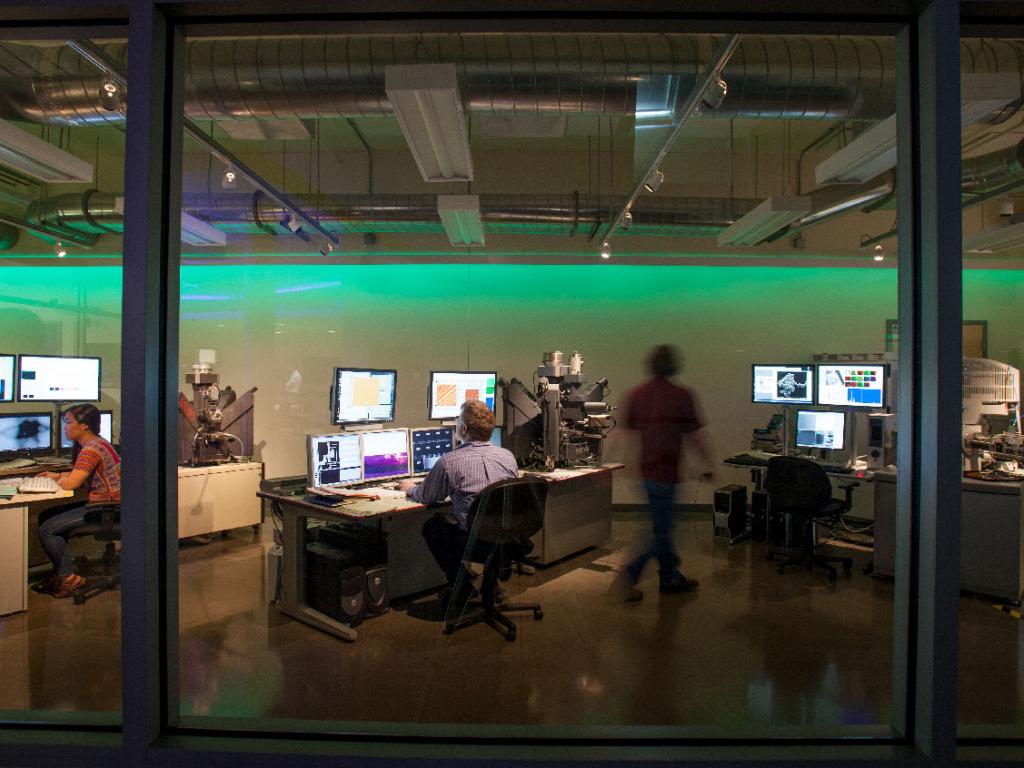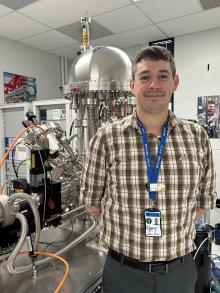
One works in the aerospace industry, another for the Fred Hutchinson Cancer Center, and the third for Fermilab. What do these people have in common? They’re all graduates of the Advanced Materials Analysis and Characterization accelerated master’s degree program (AMAC) at the University of Oregon.
Yet master’s degree programs that launch graduates into successful careers abound; what makes this one different?
Its setting. The AMAC program is housed in one of the UO’s core facilities, where students learn more than how to use a wide array of advanced scientific tools—they learn how to understand them, too. The degree is heavy on application and program graduates boast a deep level of technical understanding, making their skillsets highly desirable in industry and federal research alike.
The accelerated, 15-month program culminates in a Master of Science in chemistry. More than half of the program is spent in an internship with an industry partner. The other half includes coursework in the Center for Advanced Materials Characterization in Oregon (CAMCOR) core facility. Each cohort is just eight students to ensure each person has sufficient time to learn the tools backwards and forwards.

For Jada Ward ‘21, her degree from the AMAC program was a launchpad. Though she expected to secure a technician position following graduation, Panasonic offered her an engineer role instead because of her knowledge of X-ray photoelectron spectroscopy (XPS), focused ion beam scanning electron microscopy (FIB SEM), mechanical and thermal analysis, milling techniques, and more.
“I can use the instrument and analyze the data, plus I have a deep understanding of test methods and how to use instrumentation in real-life applications,” Ward said. “Industry really needs instrumental data analysis. At my first job, knowing these complex instruments allowed my manager to trust me with other instrumentation as well.”
Ward has since moved on to a different position in the aerospace industry, but her degree continues to serve her well.
“These skills are super niche, and every industry is looking for this skillset,” she said. “These are million-dollar instruments that not everyone can handle and learn in any university setting.”
Indeed, instruments like CAMCOR’s Titan transmission electron microscope (TEM) are rare; the UO’s TEM is used by numerous Pacific Northwest universities and companies.
When Theo Humphreys ‘19, now the associate director of electron microscopy at the Fred Hutchinson Cancer Center, wasn’t accepted into a different program and found the AMAC program somewhat by accident. However, Humphreys is first to admit the opportunities afforded to him by AMAC have greatly exceeded his expectations.
“This worked out much better,” he said. “I didn’t expect my career to have gone as well as it has. The networking in the field has been valuable. Also, the ability to troubleshoot at every stage really comes in handy, particularly since I work as the manager of the facility in my current job. The projects we see use other shared-resource labs, and there can be a disconnect between those labs—I’m often the person who can connect the dots on data that they are generating.”
While Ward and Humphreys did their undergraduate work at UC Irvine and Willamette University, respectively, Adam Clairmont ’21 majored in physics at the UO. Research projects he participated in as an undergraduate led him to the AMAC program for his master’s degree.

“I’m a bit of a hardware guy,” Clairmont said. “For years, I had ogled CAMCOR’s shiny pieces of steel from afar. I really enjoyed the hands-on nature of the AMAC program. I liked getting to turn the knobs, open the isolation valves, help with preventative maintenance and upkeep.”
Clairmont, now a staff engineer 1 for the materials science laboratory at Fermilab—America’s particle physics and accelerator national laboratory—said that having such a diversity of tools in one spot provided him with many opportunities to learn, but even more important was the instruction he received.
“CAMCOR is really special in that it doesn’t just have special tools under one roof, but also experts who can use the tools,” he said. “I 100% would not be sitting in the chair I am today without the CAMCOR staff and AMAC program. They do a wonderful job teaching people to use these sometimes very complicated tools and procedures. The AMAC program allows people to really learn the industry-leading analytic techniques widely used across many types of research.”
CAMCOR’s director, Kurt Langworthy, notes that the success of program graduates is a key metric by which he and others evaluate the program.
“Watching our students excel in their careers is a great treat for our team of instructors,” he said. “Sharing our knowledge and knowing we’ve helped impact someone’s life and career potential is a tremendously positive feeling.”
Operating and performing maintenance on high-tech microscopes are skills bolstered by such a deep knowledge of the instrumentation that Clairmont, Humphreys, and Ward view their skillsets as toolbelts.
“By learning these analytical techniques, you not only learn how to apply one, but to select one to answer a particular question,” Clairmont said. “If someone comes to me and says, ‘Here’s my problem, how do I solve it?’ I know enough about each of the tools to know which technique would be best to answer that question. That level of comfort comes only with being exposed to vast multitude of different techniques and tools. I couldn’t recommend the AMAC program more.”
